Abstract
Strain UHM-5, a pSym- Exo- derivative of the aluminum-tolerant Rhizobium leguminosarum bv. phaseoli strain CIAT899, was equally tolerant of aluminum (Al) as the parental culture. Dialyzed culture supernatants of the wild-type cells grown in YEM broth (109 cells ml-1) contained 185 μg of glucose equivalents ml-1 whereas UHM-5 culture supernatants yielded 2 μg of glucose ml-1. The Exo- derivative and the parental strain gave essentially similar growth in medium containing from 0 to 300 μM Al, indicating that the pSym of CIAT899, and extracellular polysaccharide, were not involved in the aluminum tolerance of this strain. However, increasing the level of Al from 80 to 150 μM increased the lag phase, induced a slight killing of the inoculum, and depressed the final populations by about fivefold. Doubling the aluminum concentration from 150 to 300 μM presented a severe aluminum stress to CIAT899 and UHM-5: the inoculum level dropped 10-fold, indicating killing of the inoculum, and remained depressed for ca. 4 days before continuing to grow slowly; the final population was decreased 15-fold relative to that of cultures grown in medium containing 80 μM Al. The production by CIAT899 of other extracellular or intracellular aluminum tolerance factors was investigated in culture by using aluminum-sensitive rhizobia as stress indicators. These experiments, conducted at 80 μM Al, demonstrated that CIAT899 produced neither extracellular nor intracellular products that could alleviate toxicity for the Al-sensitive indicator rhizobia.
Full text
PDF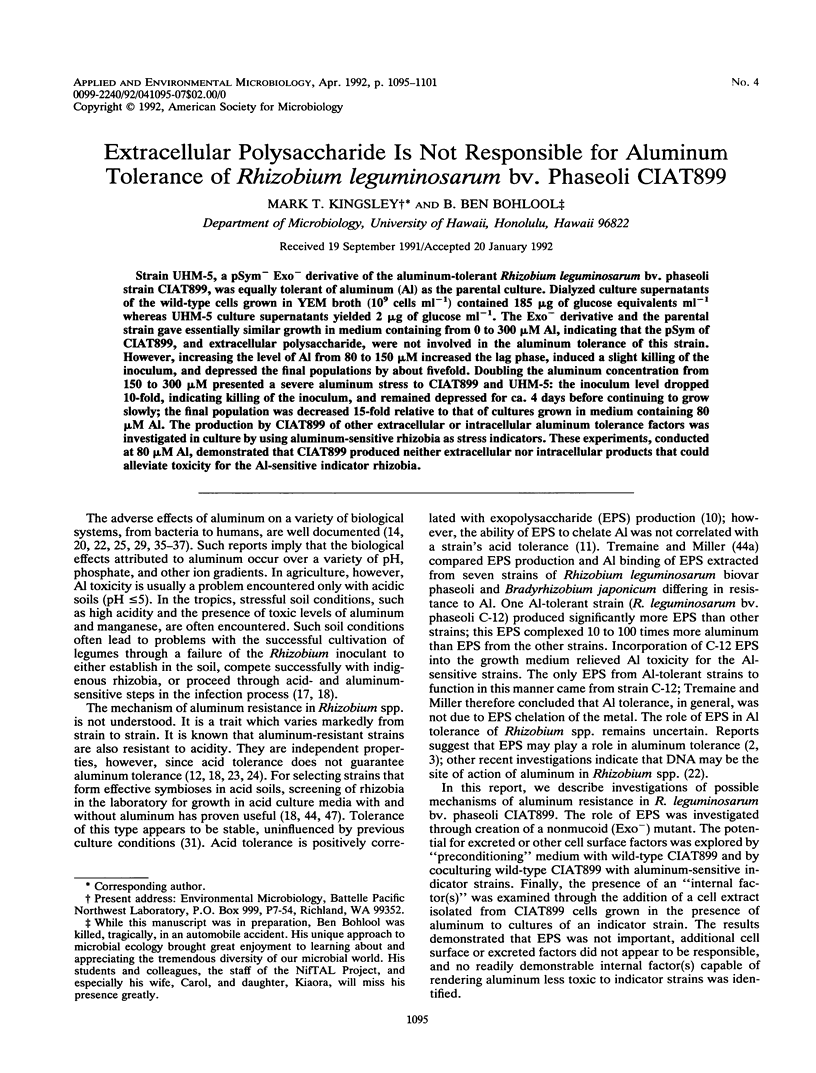
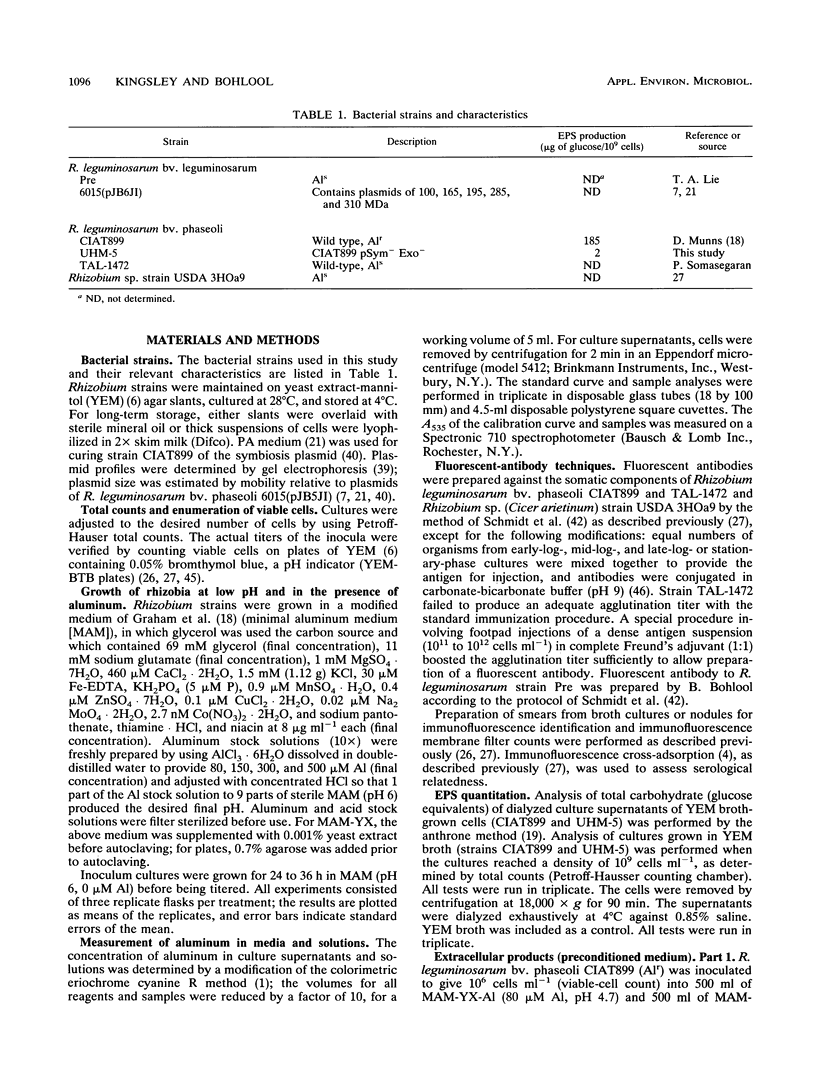
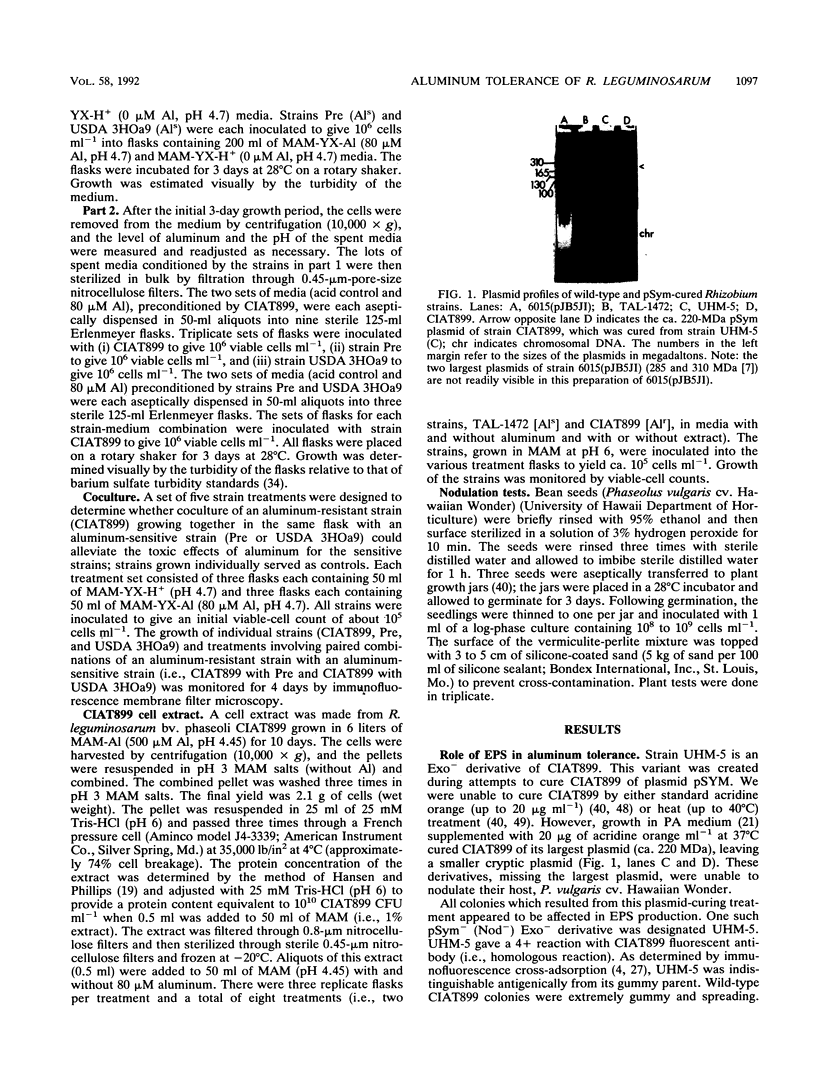

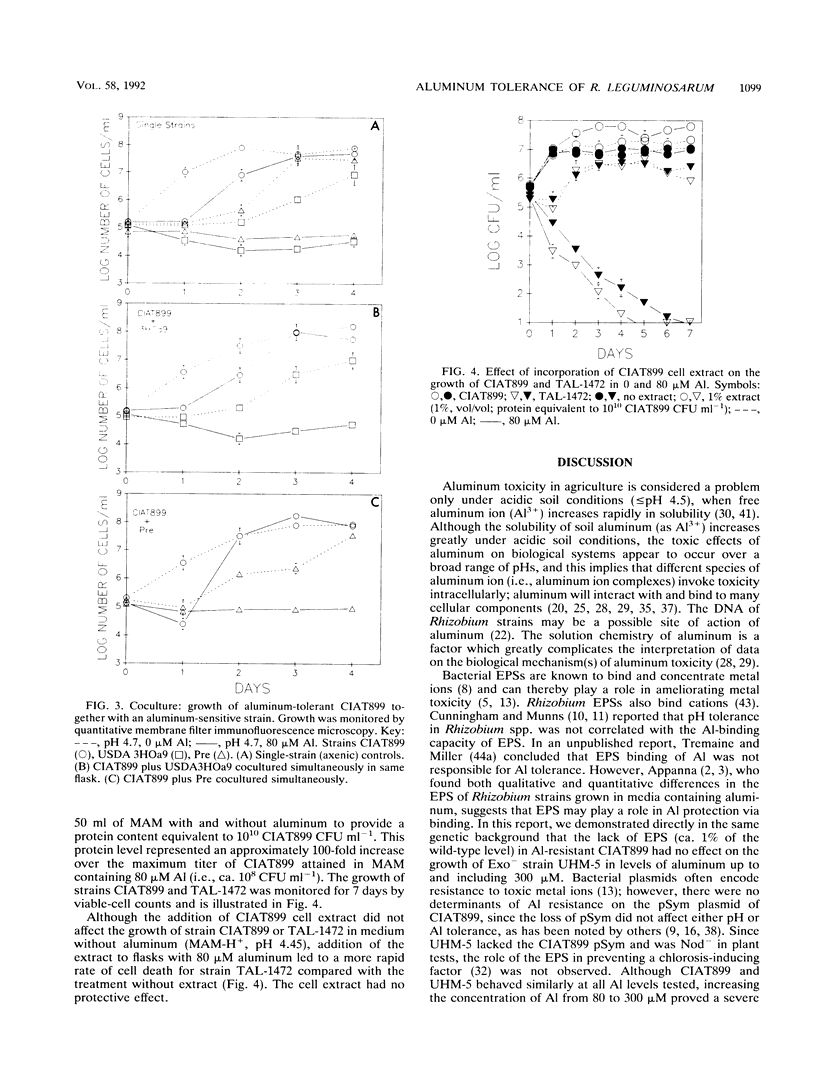

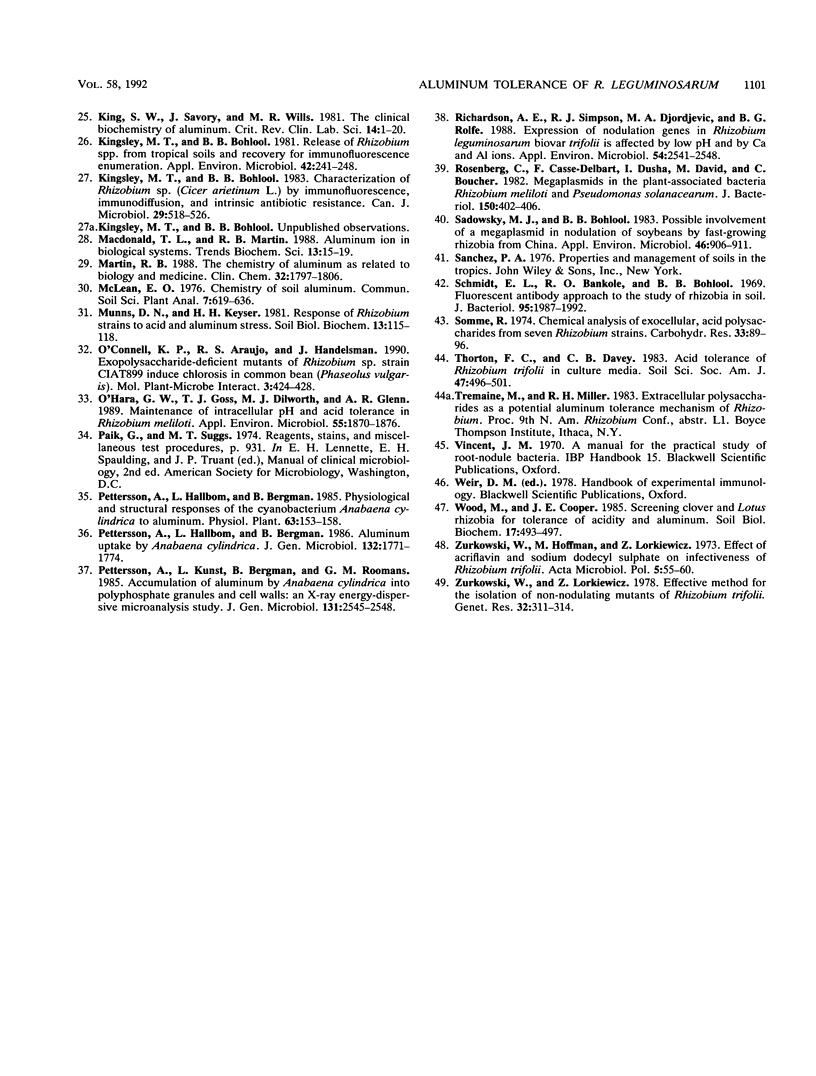
Images in this article
Selected References
These references are in PubMed. This may not be the complete list of references from this article.
- Chen H., Richardson A. E., Gartner E., Djordjevic M. A., Roughley R. J., Rolfe B. G. Construction of an Acid-Tolerant Rhizobium leguminosarum Biovar Trifolii Strain with Enhanced Capacity for Nitrogen Fixation. Appl Environ Microbiol. 1991 Jul;57(7):2005–2011. doi: 10.1128/aem.57.7.2005-2011.1991. [DOI] [PMC free article] [PubMed] [Google Scholar]
- Foster T. J. Plasmid-determined resistance to antimicrobial drugs and toxic metal ions in bacteria. Microbiol Rev. 1983 Sep;47(3):361–409. doi: 10.1128/mr.47.3.361-409.1983. [DOI] [PMC free article] [PubMed] [Google Scholar]
- Johnson A. C., Wood M. DNA, a Possible Site of Action of Aluminum in Rhizobium spp. Appl Environ Microbiol. 1990 Dec;56(12):3629–3633. doi: 10.1128/aem.56.12.3629-3633.1990. [DOI] [PMC free article] [PubMed] [Google Scholar]
- King S. W., Savory J., Wills M. R. The clinical biochemistry of aluminum. Crit Rev Clin Lab Sci. 1981;14(1):1–20. doi: 10.3109/10408368109105861. [DOI] [PubMed] [Google Scholar]
- Kingsley M. T., Bohlool B. B. Release of Rhizobium spp. from Tropical Soils and Recovery for Immunofluorescence Enumeration. Appl Environ Microbiol. 1981 Aug;42(2):241–248. doi: 10.1128/aem.42.2.241-248.1981. [DOI] [PMC free article] [PubMed] [Google Scholar]
- Macdonald T. L., Martin R. B. Aluminum ion in biological systems. Trends Biochem Sci. 1988 Jan;13(1):15–19. doi: 10.1016/0968-0004(88)90012-6. [DOI] [PubMed] [Google Scholar]
- Martin R. B. The chemistry of aluminum as related to biology and medicine. Clin Chem. 1986 Oct;32(10):1797–1806. [PubMed] [Google Scholar]
- O'hara Graham W., Goss Thomas J., Dilworth Michael J., Glenn Andrew R. Maintenance of Intracellular pH and Acid Tolerance in Rhizobium meliloti. Appl Environ Microbiol. 1989 Aug;55(8):1870–1876. doi: 10.1128/aem.55.8.1870-1876.1989. [DOI] [PMC free article] [PubMed] [Google Scholar]
- Richardson A. E., Simpson R. J., Djordjevic M. A., Rolfe B. G. Expression of Nodulation Genes in Rhizobium leguminosarum biovar trifolii Is Affected by Low pH and by Ca and Al Ions. Appl Environ Microbiol. 1988 Oct;54(10):2541–2548. doi: 10.1128/aem.54.10.2541-2548.1988. [DOI] [PMC free article] [PubMed] [Google Scholar]
- Rosenberg C., Casse-Delbart F., Dusha I., David M., Boucher C. Megaplasmids in the plant-associated bacteria Rhizobium meliloti and Pseudomonas solanacearum. J Bacteriol. 1982 Apr;150(1):402–406. doi: 10.1128/jb.150.1.402-406.1982. [DOI] [PMC free article] [PubMed] [Google Scholar]
- Sadowsky M. J., Bohlool B. B. Possible involvement of a megaplasmid in nodulation of soybeans by fast-growing rhizobia from china. Appl Environ Microbiol. 1983 Oct;46(4):906–911. doi: 10.1128/aem.46.4.906-911.1983. [DOI] [PMC free article] [PubMed] [Google Scholar]
- Schmidt E. L., Bakole R. O., Bohlool B. B. Fluorescent-antibody approach to study of rhizobia in soil. J Bacteriol. 1968 Jun;95(6):1987–1992. doi: 10.1128/jb.95.6.1987-1992.1968. [DOI] [PMC free article] [PubMed] [Google Scholar]
- Somme R. Chemical analysis of exocellular, acid polysaccharides from seven Rhizobium strains. Carbohydr Res. 1974 Mar;33(1):89–96. doi: 10.1016/s0008-6215(00)82942-0. [DOI] [PubMed] [Google Scholar]
- Zurkowski W., Hoffman M., Lorkiewicz Z. Effect of acriflavine and sodium dodecyl sulphate on infectiveness of Rhizobium trifolii. Acta Microbiol Pol A. 1973;5(2):55–60. [PubMed] [Google Scholar]



